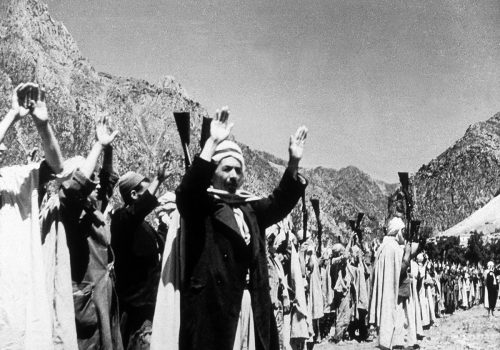On the occasion of the release of the book “French decolonizations. The fall of an Empire “, Fabrice Héron, iconographer-researcher, who carried out the iconographic research of the book returns to the imagery of decolonization.
A project that brought together nearly 3000 images of all kinds (drawing, poster, photography) produced between 1943 and 1976, nearly 300 of which are published in the work and some unpublished in the article.
————————
Text by Fabrice Héron
After the chaos of the Second World War, the colonial domain was the guarantee that France would remain among the great nations. However, the concept of the city’s superiority over the colonies was deeply shaken by the shock of the defeat of 1939-1940. Humiliation heightened by the victory of 1944 partly due to the effort of the colonies. The weakening of the colonial system cannot curb its inevitable outcome with the displayed anti-colonialism of the United States and the USSR, the United Nations Charter which in 1945 enshrined the “right of peoples to self-determination”, the forum offered by the UN to the newly independent countries like India in 1947 and Indonesia in 1949, the strengthening of nationalist parties in all the colonies…
While colonial imagery occupies a relatively recent place in public debate, the iconographic study of decolonization remains little exploited although visited by researchers like P. Blanchard and L. Gervereau. What place do colonization and the Empire occupy in former and contemporary opinion? The corpus of images makes it possible to document this history and as much as possible to analyze it to better understand it and go beyond it.
From the XIXth century, the dominant colonial culture produced such a quantity of iconography through a multitude of supports (posters, leaflets, photographs, current films, cinema, etc.) and everyday objects – called the “colonial bath – that the weight in mentalities is still felt today to the point of influencing French society. Conversely, anticolonialism has hardly left traces in the memories of the iconographic point of view in comparison with the overwhelming state propaganda. Who remembers images of demonstrations in Ivory Coast and Cameroon to drive out French settlers?
It would be difficult to understand the links between colonial imagery and political issues without considering at the outset the specificity of the twentieth century, since for the first time power struggles were accompanied by the massive use of visual aids. We are witnessing the emergence of mass visual media in the service of a cause and its antagonism, colonial power and the colonized.
When the doxa retains the images of the repression of Algerian demonstrators at the Charonne metro immortalized by photographers like Elie Kagan or the many conflicts in New Caledonia, do we know those of the riots in Guadeloupe in 1967 or the last French victims in Djibouti ?
How to decolonize the colonial image even though the term decolonization has long been obscured because it is considered to be contrary to the French political foundations which link the Metropolis to the Overseas Territories. In the society of the 1950s and 1960s, decolonization did not exist outside the prism of East-West confrontation. The European nations engage, in spite of some important colonial reforms, in a long period of overseas conflicts witnessing a succession of three major colonial wars, in Indochina, Algeria and Cameroon, the repercussions of which are still strong today. passions, memories and ambivalences.
1943-1954: between the pursuit of the colonial dream and the faltering of the Empire …
While the colonies allow France to sit at the table of the victors, they see emerging at the same time nationalist elites calling for their independence like Ho Chi Minh in Vietnam, Messali Hadj and Ferhat Abbas in Algeria, Habib Bourguiba in Tunisia, Léopold Sedar Senghor in Senegal, Félix Houphouët-Boigny in Côte d’Ivoire, Aimé Césaire in Martinique, etc. If the collective imagination has retained their post independence portraits who knows a photograph of them showing them in struggle against colonial power? These images are rare, they are not intended to circulate freely with the public.
On the French side we are witnessing a double discourse between the Conference of Brazzaville in 1944 and the law of departmentalization of 1946 on one side, and on the other the first emancipations of the French mandates in the Levant (Syria and Lebanon) and the first massacres colonialists in Constantinois in 1945, Madagascar in 1947, the bombing of Haiphong in Indochina in 1946 and that of Damascus in 1948. It is colonial violence that is necessary at the expense of an end to the political crisis. What remains of these images? Long prevented and largely carried out from the point of view of the power in place, they finally come out thanks to the work of historians, documentalists and archivists.
From 1945, the colonial discourse continued its discourse of self-justification, magnifying economic and social progress as well as the infrastructure and health programs, of which the colonized would be the beneficiaries. The massive use of photography by the Colonial Economic Agency became the main vector of official discourse on the eve of independence. The vast majority of these photos were used for brochures, magazines and books, both official and private. The greatest photographers of the time are mobilized, such as François Kollar, Germaine Krull, André Martin, Bernard Lembezat, Pierre Verger, Léon Herschritt or Claude Sauvageot. Photographic and cinematographic missions are organized in the colonies, providing the Agency with thousands of images. Exoticism still permeates iconographic production, in particular tourist posters, colonial cinema or illustrated books for young people. However, the multiplication of illustrations on the “enhancement” of the continent models a new image of the colonized, at the service of the development of “their” country. (…)
The complete text can be found in the French edition of The Eye of Photography
Les Iconographes https://www.iconographes.com/
















